Wikipedia:Picture of the day/March 2013
|
Featured picture tools: |
These featured pictures, as scheduled below, appeared as the picture of the day (POTD) on the English Wikipedia's Main Page in March 2013. Individual sections for each day on this page can be linked to with the day number as the anchor name (e.g. [[Wikipedia:Picture of the day/March 2013#1]] for March 1).
You can add an automatically updating POTD template to your user page using {{Pic of the day}} (version with blurb) or {{POTD}} (version without blurb). For instructions on how to make custom POTD layouts, see Wikipedia:Picture of the day.Purge server cache
March 1

|
The Wood Sandpiper (Tringa glareola) is a Eurasian wader. The smallest of the shanks, it is usually found near fresh water. This specimen, in non-breeding plumage, was found in Laem Phak Bia, Thailand. Photo: JJ Harrison
Recently featured:
|
March 2

|
Rutherford B. Hayes (1822–93), the 19th President of the United States. After 20 electoral votes in the election of 1876 were disputed, the U.S. government established an Electoral Commission which awarded the votes to Hayes, a Republican. The Democrats began a filibuster to block Hayes' appointment, but after an unwritten compromise, on 2 March 1877 the filibuster ended; Hayes was sworn in as president two days later. Photo: Mathew Brady; Restoration: UpstateNYer
Recently featured:
|
March 3

|
A map showing the geography of Florida, a state in the United States. Situated on a peninsula between the Gulf of Mexico, the Atlantic Ocean, and the Straits of Florida, Florida has an extensive coastline. Its highest point, Britton Hill, is the lowest highpoint of any U.S. state. Florida is home to over 19 million people, living in 410 municipalities. Map: Eric Gaba
Recently featured:
|
March 4
|
An Indian palm squirrel (Funambulus palmarum) photographed in Bangalore, India. In India these squirrels are associated with the Hindu deity Rama, an avatar of Vishnu, and as such are not to be harmed. However, in Western Australia they are considered pests and at times targeted for eradication. Photograph: Muhammad Mahdi Karim
Recently featured:
|
March 5

|
A portrait of an African elephant, highlighting its trunk. The trunk, which contains some 150,000 muscle fascicles, is a fusion of the nose and upper lip with a unique nerve running along both sides. An elephant can use its trunk for power functions, such as lifting up to 350 kg (770 lb), or more delicate functions, such as wiping its eye. Photograph: Muhammad Mahdi Karim
Recently featured:
|
March 6

|
Turku Castle is a monument located in Turku, Finland. Initially intended as a military fortress, construction on the castle began in the 13th century. It was destroyed and rebuilt several times and now houses a museum, church, restaurants, and banquet hall. Photograph: Otto Jula
Recently featured:
|
March 7

|
A Red-wattled Lapwing (Vanellus indicus), a large wader, photographed in Thailand. Red-wattled Lapwings are found in much of Asia, where they prefer well-watered open country, ploughed fields, grazing land, and margins and dry beds of tanks and puddles. Photograph: JJ Harrison
Recently featured:
|
March 8

|
The Patrouille de France, a precision aerobatic demonstration team, in full formation at the Radom Air Show. The team was established as part of the French Air Force in 1947, although aerobatic teams had existed in the country since 1931. The Patrouille fly Dassault/Dornier Alpha Jets. Photograph: Łukasz Golowanow
Recently featured:
|
March 9

|
The missing square puzzle is an optical illusion used in mathematics classes to help students reason about geometrical figures. It depicts two arrangements of shapes, each of which apparently forms a 13×5 right-angled triangle, but one of which has a 1×1 hole in it. Picture: Fibonacci
Recently featured:
|
March 10
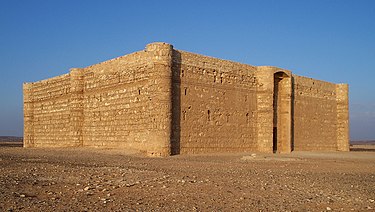
|
Qasr Kharana is a desert castle in Jordan. Completed by 710 C.E., the building survived several earthquakes before being restored in the late 1970s. It is open to the public and has become the most visited such castle in Jordan. Photograph: High Contrast
Recently featured:
|
March 11

|
The Chestnut-headed Bee-eater (Merops leschenaulti) is a bird found in South and Southeast Asia. Averaging 18–20 centimetres (7.1–7.9 in) in length, the bird prefers eating insects such as bees. Photo: JJ Harrison
Recently featured:
|
March 12
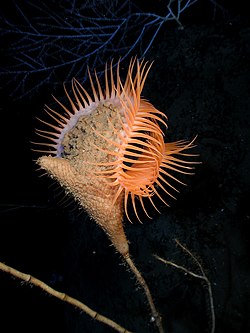
|
The Venus flytrap sea anemone (Actinoscyphia aurelia) is a large sea anemone superficially resembling a Venus flytrap. Found in deep water canyons in the Gulf of Mexico, the anemone orients itself to face the upwelling current and catches prey with its tentacles. Photo: NOAA
Recently featured:
|
March 13

|
Uranus is the seventh planet from the Sun and the fourth most massive in the Solar System. In this photograph from 1986 the planet appears almost featureless, but recent terrestrial observations have found seasonal changes to be occurring. Photo: NASA/JPL/Voyager 2 mission
Recently featured:
|
March 14

|
The Great Picture is a 32-by-111-foot (9.8 by 33.8 m) photograph on muslin taken in 2006 as part of the Legacy Project, a photographic compilation and record of the history of now-closed Marine Corps Air Station El Toro. It was taken by converting an old hangar into a pinhole camera. Photo: Rob Johnson
Recently featured:
|
March 15

|
Robin Hunicke (b. 1973) is an American video game designer and producer who worked for several companies before establishing her own, Funomena, in 2011. She also supports independent game development. Photo: Charlie Chu
Recently featured:
|
March 16

|
The Black-winged Stilt (Himantopus himantopus) is a widespread wader which feeds mainly on insects and crustaceans. They breed near marshes, shallow lakes and ponds. Photo: JJ Harrison
Recently featured:
|
March 17

|
Thelephora palmata is a widespread species of clavarioid fungus. It is commonly known as the stinking earthfan for its fetid odor, which intensifies after drying. Photo: H. Krisp
Recently featured:
|
March 18
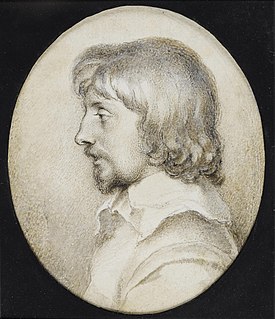
|
An 8.8-centimetre (3.5 in) tall self-portrait of the English miniaturist Peter Oliver (1594–1648). He often worked with watercolours. Portrait: Peter Oliver
Recently featured:
|
March 19

|
A Bell Boeing V-22 Osprey flying over the U.S. state of New Mexico in August 2007. A prototype version of the aircraft first flew in 1989, followed by a long and difficult development process necessitated by its complex tiltrotor system. Photo: Staff Sgt. Markus Maier, USAF
Recently featured:
|
March 20

|
Satellite photographs showing massive flooding in Thailand. In late July 2011, before the floods began, the Chao Phraya River curved through the provinces of Ayutthaya and Pathum Thani (left). By October the river had overflowed and submerged fields, roads and buildings in most of the area (right). Photo: NASA Earth Observatory
Recently featured:
|
March 21
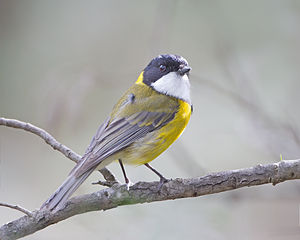
|
The Australian Golden Whistler (Pachycephala pectoralis) is a species of bird found in Australia and parts of Indonesia. Males, like the one pictured here, have a bright yellow underside and nape, olive-green back and wings, a black head and chest-band, and a white throat; females are generally a dull brownish-grey. Photo: JJ Harrison
Recently featured:
|
March 22

|
Drymoreomys is a genus of South American rodent represented by a single species, D. albimaculatus. First formally described in 2011, the species prefers dense, moist, montane and premontane forest. Morphological evidence suggests they are tree dwellers. Photo: Luís Funez
Recently featured:
|
March 23
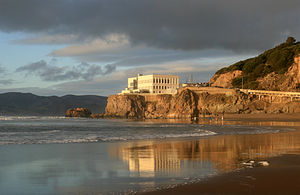
|
Cliff House is a building located above the cliffs of Ocean Beach, on the western side of San Francisco, US. Part of the Golden Gate National Recreation Area, it houses two restaurants and a room-sized camera obscura. Photo: Mbz1
Recently featured:
|
March 24

|
Thermite is a pyrotechnic composition of a metal powder and a metal oxide that produces extremely high temperatures focused on a very small area for a short period of time. Pictured here is a thermite reaction using iron(III) oxide; the sparks flying outwards are globules of molten iron trailing smoke in their wake. Photo: Nikthestunned
Recently featured:
|
March 25

|
The Commodore 64 is an 8-bit home computer introduced in 1982 by Commodore International. Its low retail price and easy availability led to the system becoming the market leader for three years. It remains the best-selling single personal computer model of all time. Photo: Evan Amos
Recently featured:
|
March 26

|
Unripe drupes of black pepper (Piper nigrum) at Trivandrum, Kerala, India. The drupes are cooked briefly in hot water. The heat ruptures cell walls in the pepper, speeding the work of browning enzymes during drying. The drupes are dried for several days, during which the pepper around the seed shrinks and darkens into a thin, wrinkled black layer. Once dried, the spice is called black peppercorn. Photo: K Hari Krishnan
Recently featured:
|
March 27

|
A film poster for Island of Lost Men, a 1939 American film directed by Kurt Neumann and starring Anna May Wong and J. Carrol Naish. It followed a general's daughter who looks for her father after he disappears and winds up in a labor camp. The film, originally titled Guns for China, received middling reviews. Poster: The Other Company
Recently featured:
|
March 28

|
Maxim Gorky (1868–1936) was a Russian political activist and writer who helped establish the Socialist Realism literary method. This portrait dates from a trip Gorky made to the United States in 1906, on which he raised funds for the Bolsheviks. During this trip he wrote his novel The Mother. Photo: Herman Mishkin; Restoration: Fallschirmjäger
Recently featured:
|
March 29
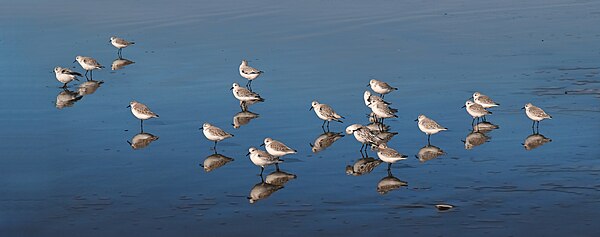
|
|
A flock of Sanderlings (Calidris alba) at Ocean Beach, San Francisco, US. The species is highly gregarious in winter, sometimes forming large flocks on coastal mudflats or sandy beaches. Photo: Brocken Inaglory
Recently featured:
|
March 30

|
|
A panoramic view of the Belvedere of Tragara in Capri, Italy, in summer. The island is a popular destination for Italian and international tourists, and can be easily reached by sea from Naples. Visible behind the city is Mount Solaro. Photo: Paolo Costa Baldi
Recently featured:
|
March 31
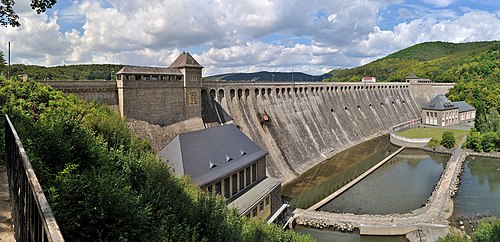
|
|
The Edersee Dam is a hydroelectric dam constructed between 1908 and 1914 across the Eder River, near Waldeck, Germany. The dam pictured here was built after the original one was destroyed by bouncing bombs during World War II. Photo: Carschten
Recently featured:
|
Picture of the day archives and future dates

